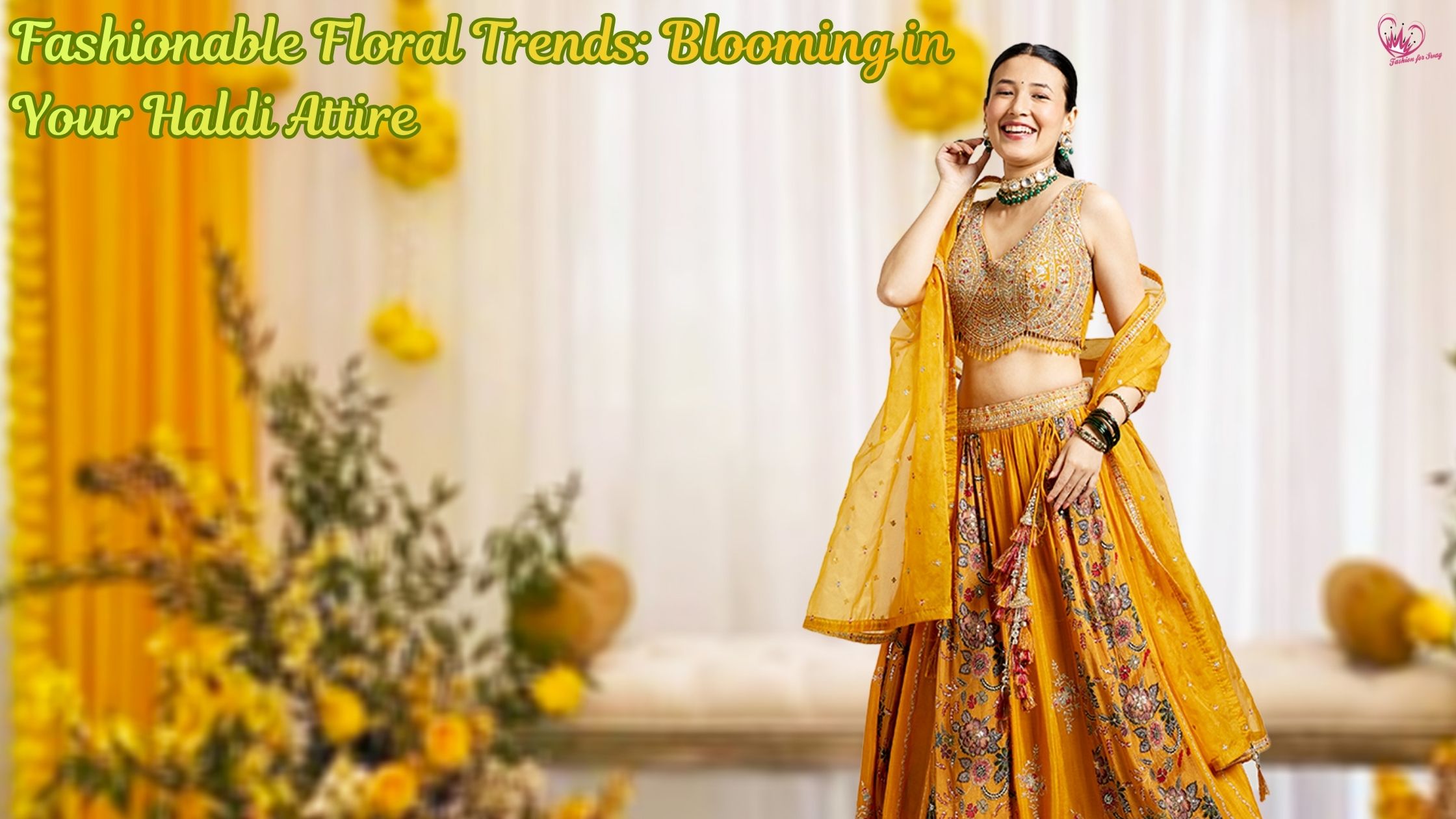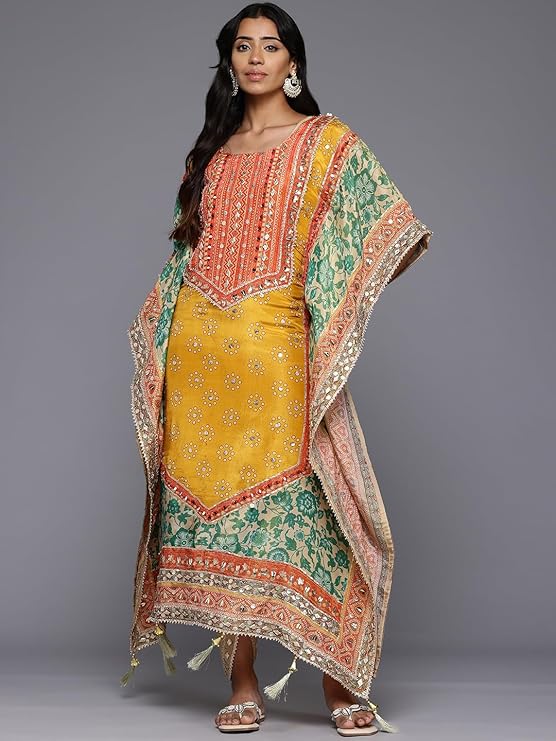
🌼 Fashionable Floral Trends: Blooming in Your Haldi Attire
The Haldi ceremony, or Pithi, is one of the most vibrant and joyous pre-wedding rituals in Indian culture. It is an event full of auspiciousness, where turmeric paste is applied to the bride and groom for purification, protection from evil eye and to provide a radiant glow before the wedding. The traditional color codes – bright yellow, signifying turmeric – have always created a vivid canvas.
In recent years, the attire scenario of the Haldi ceremony has moved beyond simple yellow sarees and kurtas. Modern bridal fashion has embraced the “floral craze”, which has transformed dresses and decorations into an elaborate, fashionable spectacle that directly complements the natural theme of the ceremony. Flowers are no longer just an accessory; They are the central motif, which determines the choice of fabric texture, embellishment techniques and silhouette.
🌿 The Root of the Trend: Significance of Florals in Haldi
To understand this trend, one must first recognize the intrinsic connection between flowers and the Haldi ceremony:
- Auspiciousness and Purity: Flowers, especially the ubiquitous marigold (marigold), are symbols of auspiciousness, new beginnings, and purity in Hindu culture. Their golden-yellow and orange color matches the color of turmeric paste perfectly.
- Natural Beauty: Turmeric is a ritual to enhance natural beauty. Wearing flowers – the essence of nature – reinforces this theme, in contrast to the heavy, ornate gold and diamond jewelery saved for the main wedding day.
- Bohemian and playful vibe: Unlike the formality of a wedding or reception, Haldi is meant to be fun, messy and casual. Floral prints and fresh accessories offer a bohemian, effortless charm that can be spoiled by heavy silks and crystals.
🖼️ The Fabric Evolution: Modern Floral Motifs
The most significant change in haldi attire is how the floral element is integrated into the attire. The focus shifted from abstract patterns to highly detailed, tangible and dramatic floral expressions:
A. Trend 1: 3D and Appliqué Florals
This is the hottest high-fashion trend, giving a sculptural and tactile dimension to the outfit.

- Technique: Designers are using a variety of fabrics such as silk, organza and velvet scraps to individually cut and hand-sew three-dimensional flowers onto the garment.
- Effect: Flowers literally “bloom” from the fabric. This works exceptionally well on soft, pastel organza sarees or lehengas, where the transparent background allows the 3D flower to become the focal point.
- Turmeric Application: Since the haldi ceremony can be messy, 3D work is often focused on the blouse, edges of the dupatta, or the lower hemline of the lehenga, with such areas less likely to be completely saturated with the paste.
B. Trend 2: Hand-Painted and Sketchy Prints
Moving away from digital perfection, modern prints adopt an artistic, watercolor aesthetic.

- Technique: Digital prints are now mimicking the look of hand-painted botanicals – oversized, slightly imperfect, and soft-focus florals that look as if they were sketched in a garden.
- Effect: This style is perfect for the light, airy fabrics required for haldi: chiffon, georgette and cotton-silk. It creates a feeling of fusion of seamless European summer with Indian festivity.
- Color Palette: While yellow remains prominent, these prints often include contrasting colors like hot pink, emerald green and cobalt blue, which stand out beautifully against the turmeric-stained background.
C. Trend 3: Gota Patti and Mirror Work Florals
For those who prefer traditional embellishments but still want floral motifs, their focus becomes on texture.

- Technique: Gota Patti (ribbon work) is intricately shaped into stylish floral vines and bootas (motifs). It adds the needed metallic luster without the weight of heavy zari or zardozi.
- Mirror Work (Abla): Small circular mirrors are embedded within the floral patterns, capturing daylight and adding a joyful, playful glow that is perfect for a daytime outdoor ceremony.
- Fabric: Usually seen on light silk, chanderi or cotton fabrics.
👗 The Silhouette Evolution: Comfort Meets Couture
The messiness of the Haldi ceremony dictates that the dress prioritize comfort and mobility. Designers have responded by re-imagining the traditional Indian silhouette with a contemporary, floral-friendly spin:
| Silhouette Trend | Description | Floral Integration | Why it’s a Haldi Hit |
| The Kaftan-Co-ord | A long, flowy, and loose-fitting tunic (Kaftan) paired with straight palazzo pants or an attached inner skirt. | Large-scale floral prints or light, dispersed floral embroidery on the neckline and cuffs. | Maximum comfort, ultimate ease of movement, and looks effortlessly chic. Ideal for concealing pre-wedding jitters. |
| The Pre-Draped Saree | A saree that is pre-stitched and fixed, often with ruffles or a belt (kamarbandh) for structure. | Printed florals on lightweight chiffon/organza, sometimes featuring a 3D floral belt or shoulder embellishment. | Eliminates the hassle of draping, perfect for dancing, and resistant to coming undone during the application of Haldi. |
| The Dhoti/Sharara Set | A short, fitted kurta paired with flared sharara pants or cuffed dhoti pants. | All-over fine Chikankari floral embroidery or subtle sequin work shaped like flowers. | Youthful, modern, and excellent for movement. The shorter length keeps the hem clean. |
| The Cape-Skirt Set | A cropped blouse and fluid skirt topped with a sheer, floor-length cape. | The cape is the canvas for heavy floral appliqué or dramatic, cascading floral prints. | Provides drama and elegance without the weight of a heavy dupatta, acting as a “veil” for the ritual. |
🌸 The Essential Accessory: Floral Jewellery Debate
The floral trend culminates in the essential turmeric accessory: floral jewellery. Here, a stark difference exists between the natural, fleeting beauty of fresh flowers and the sheer longevity of artificial materials.
A. The Enduring Charm of Fresh Flower Jewellery
- Look: Authentic, fragrant and completely natural. Fresh flowers provide a unique organic texture and softness that no synthetic material can fully replicate.
- Flower Options:
- Marigolds and Roses: Traditional favorites. Marigolds (yellow/orange) are used for volume and color base, while roses (pink, white, yellow) are used for larger statement pieces like necklaces and earrings.
- Baby’s Breath (Gypsophila): Used to add cloud-like, whimsical texture, especially in flower crowns, hand flowers (hand harnesses), and cascading hair braids (pula jada).
- Jasmine (Mogra): Its small, white buds are used to make delicate cords for necklaces and gajras, adding an intoxicating natural aroma.
- Haldi Styling: Fresh flowers look best with simple, minimal outfits (like a plain silk saree or a simple cotton kurta) to keep the look from becoming overwhelming. They are the statement, and the outfit is the canvas.
B. The Practicality of Artificial/Gota Patti Flower Jewellery
The aversion to fresh flowers (due to tangling, staining and high cost) has given rise to the artificial and gota jewelery market.
- Look: Light, non-destructive and vibrant. Modern artificial ornaments use high quality foam and silk to mimic the texture of real petals. Gota Patti jewelery uses metallic ribbons to create floral motifs, adding a festive sparkle.
- Main Benefits:
- Durability: They will not fade or stain the attire, making them ideal for messy haldi rituals.
- Customizable: Colors can be matched exactly to the print of the dress (for example, specific shades of lavender or pastel blue).
- Souvenir Value: These can be kept as souvenirs long after the wedding.
- Balance: To avoid the “sticky” look (a common criticism), brides now often opt for a mix: fresh flowers for the maang tikka and earrings (closest to the face), and gota patti or small artificial flowers for the hand flowers and bangles (the areas where the turmeric paste will get applied the most).
Finally, floral trends in haldi attire indicate a beautiful marriage between cultural tradition and contemporary high fashion. Embracing dramatic 3D textures, artistic hand-painted prints and fun, wearable silhouettes, the Haldi ceremony has truly become a fashion moment where the bridal party is encouraged to wear their hearts and their favorite flowers on their sleeves.



